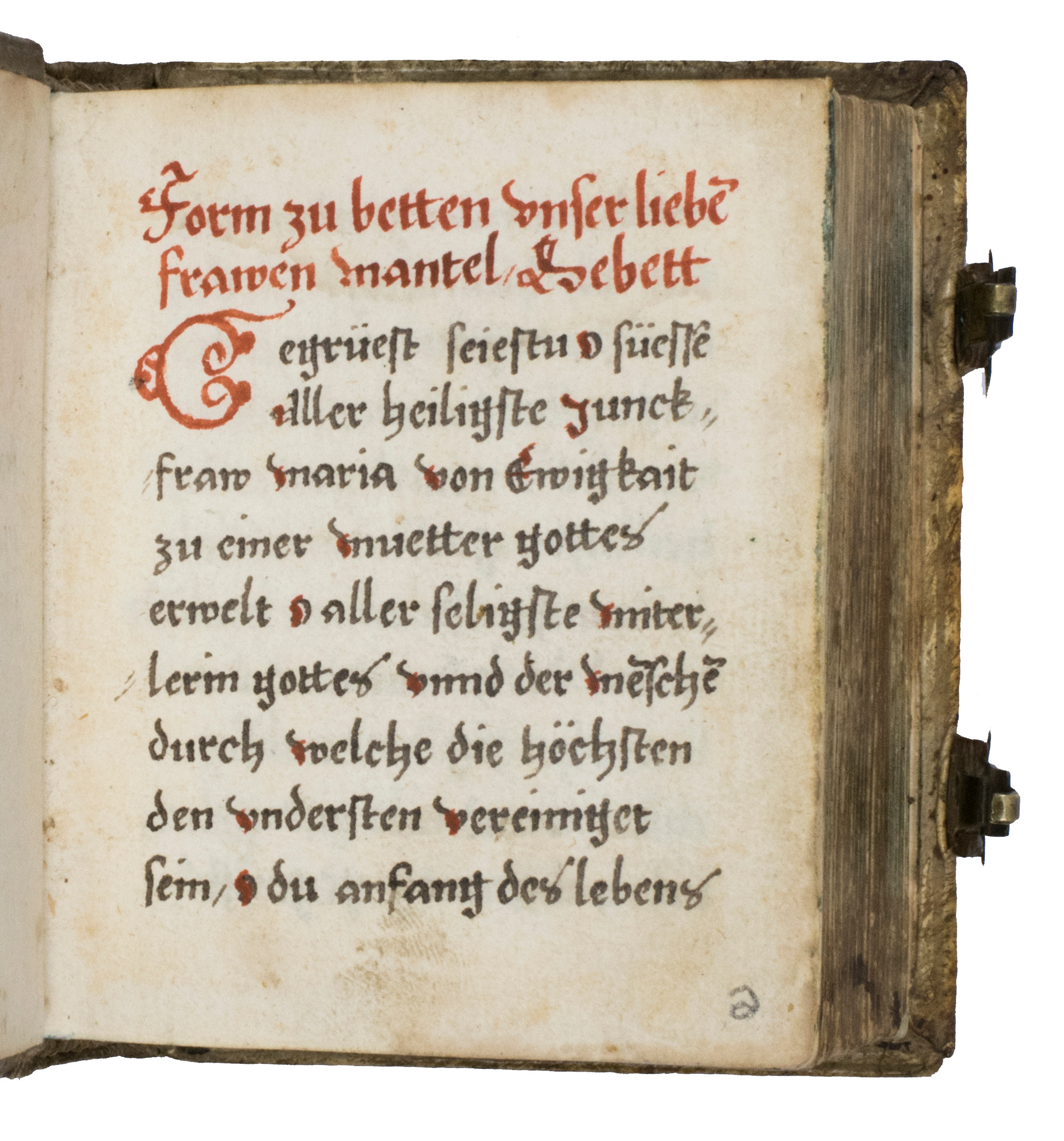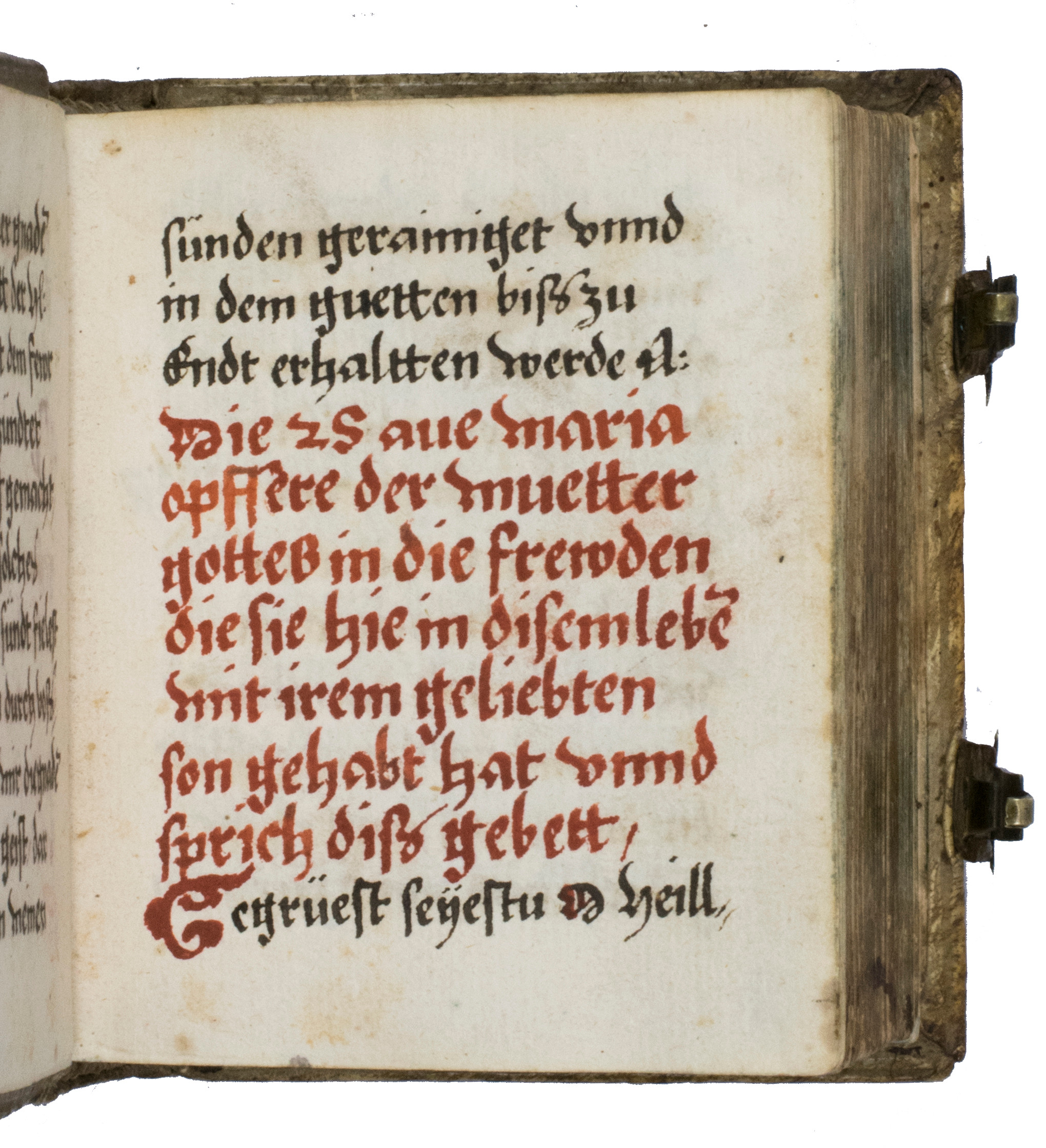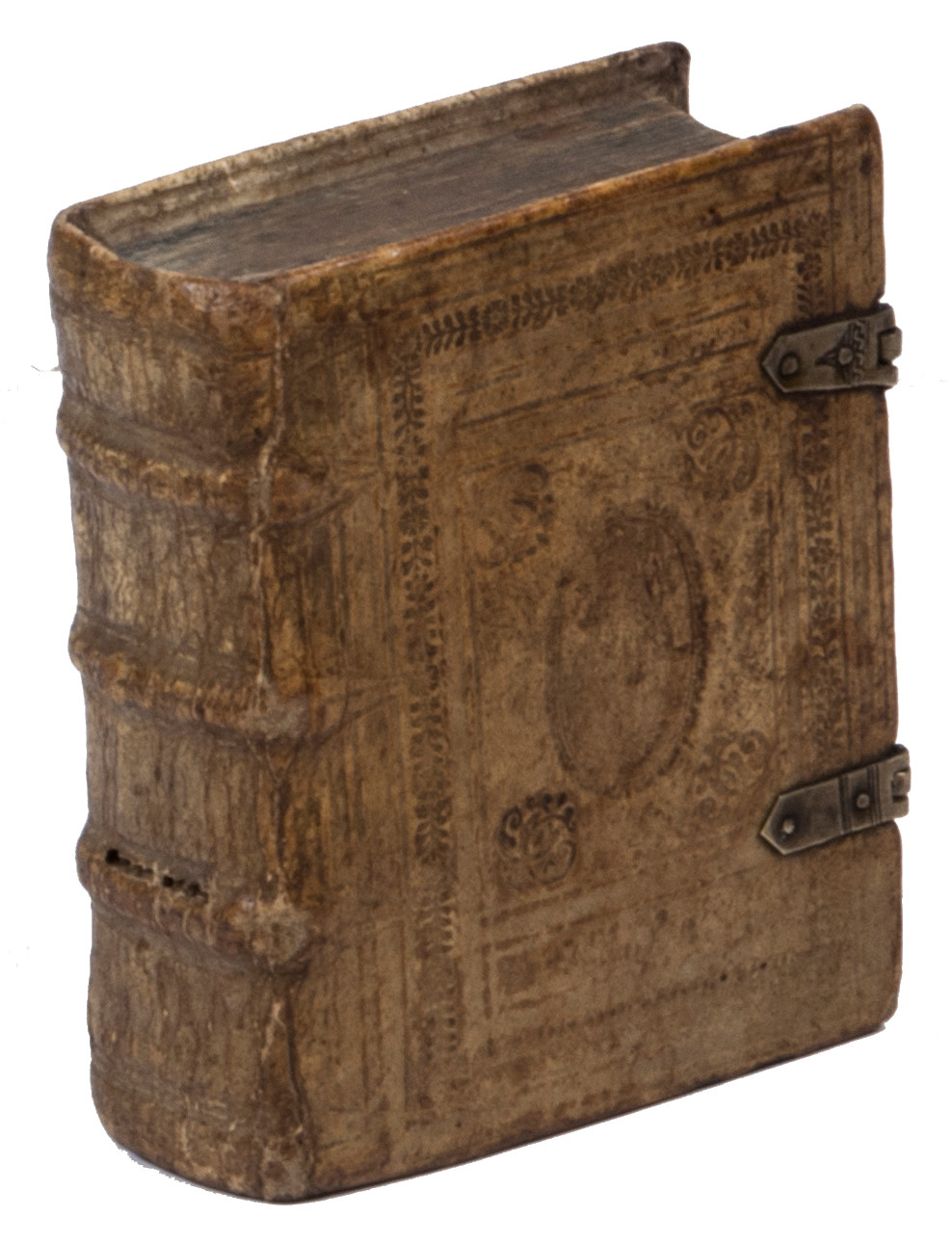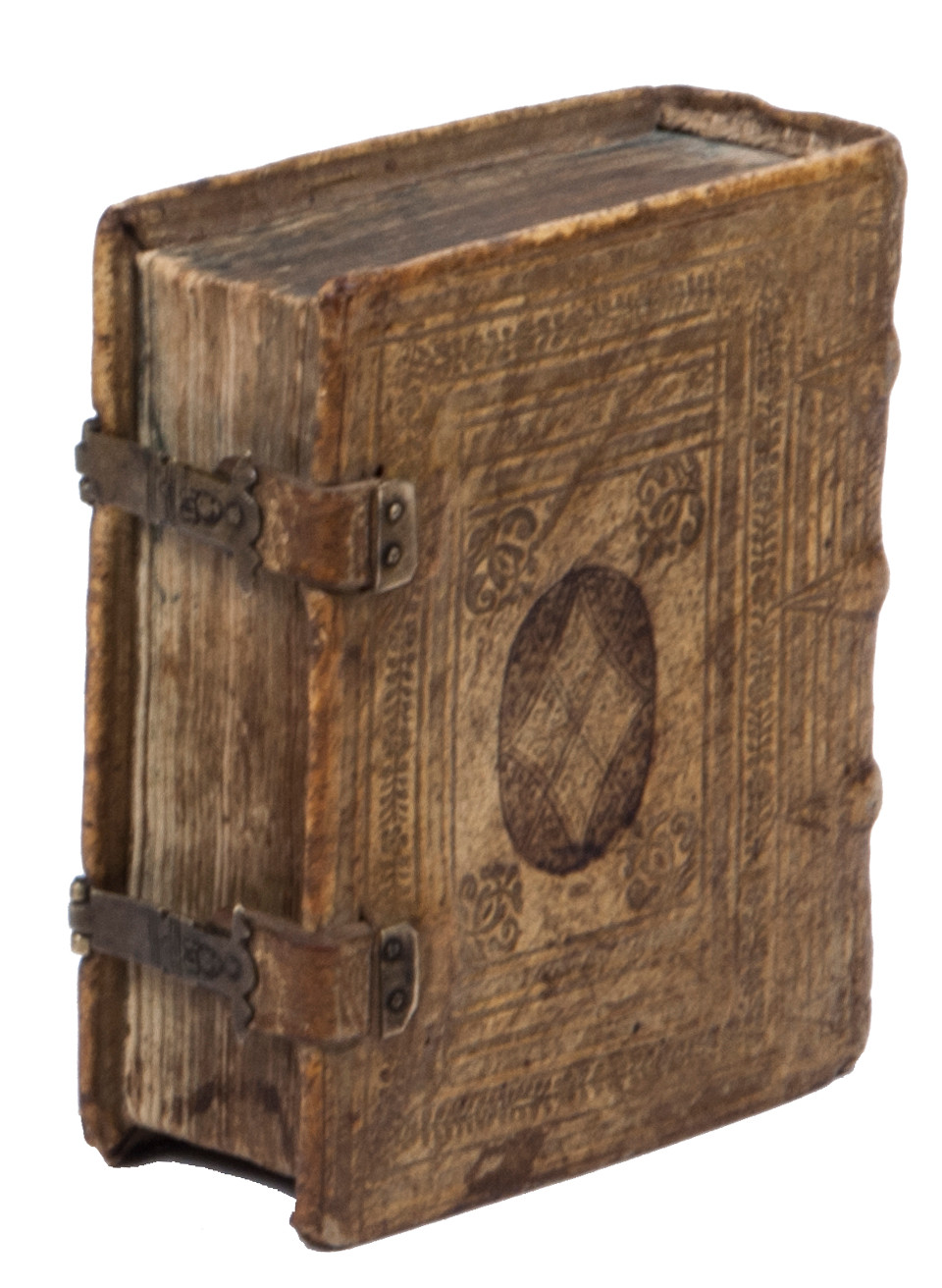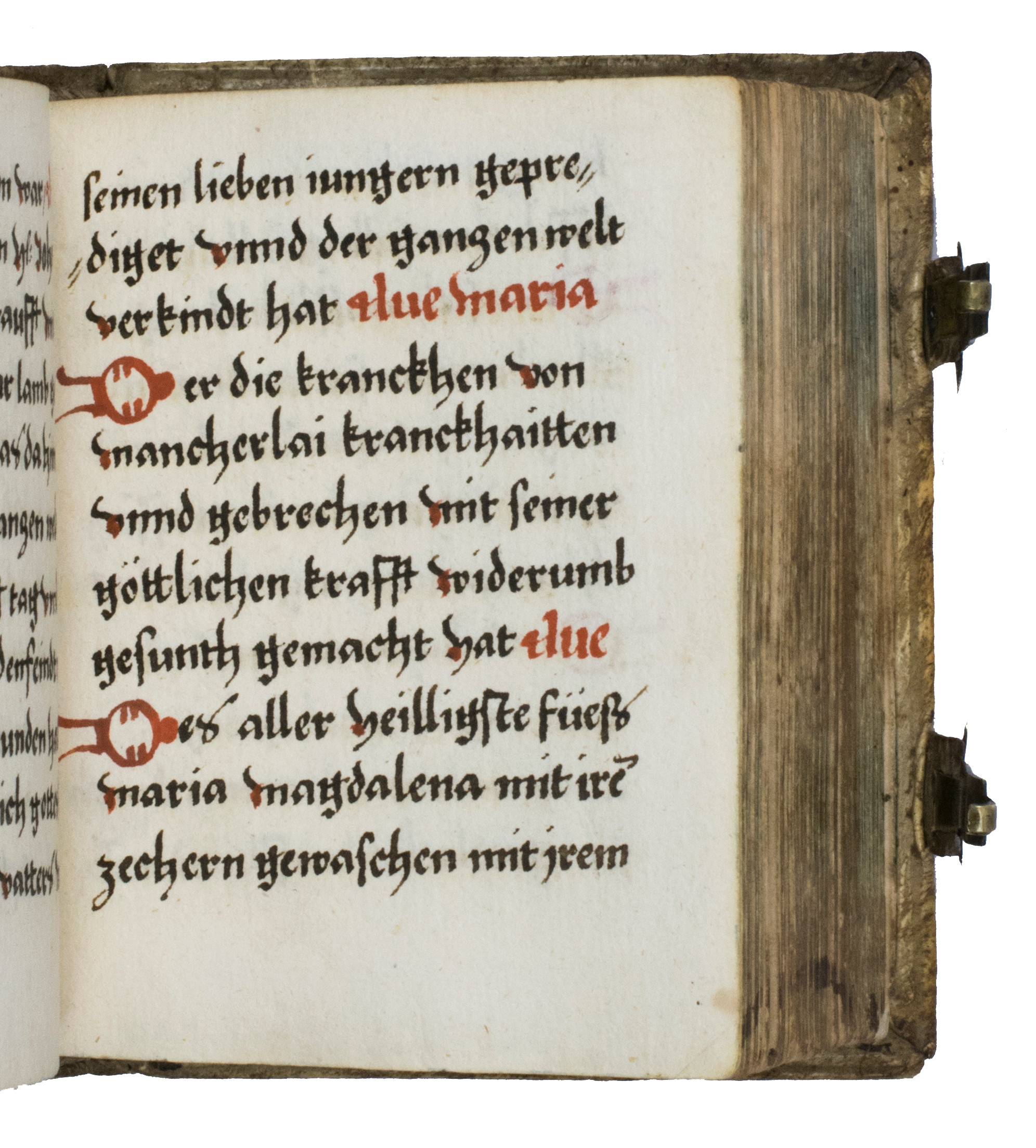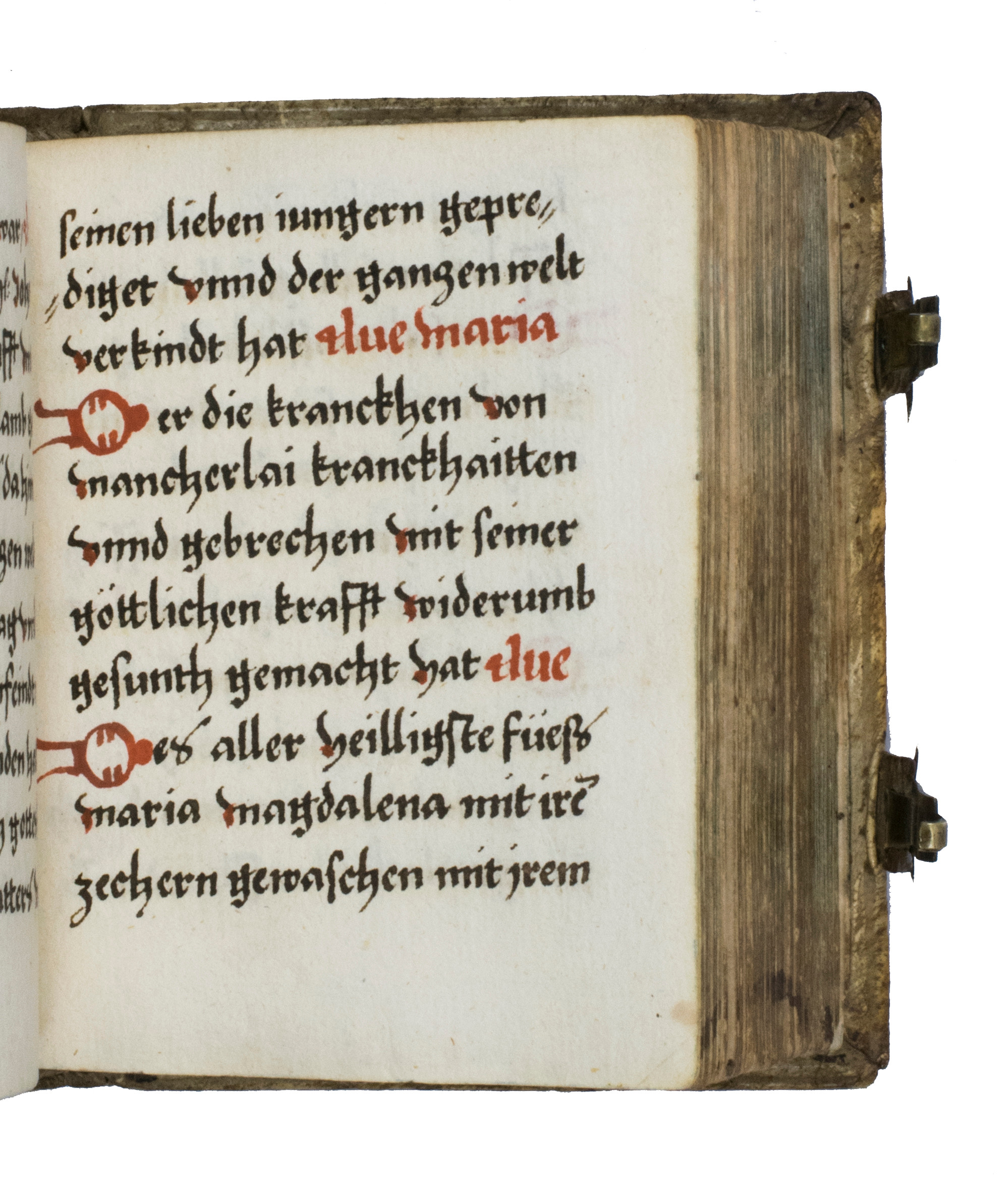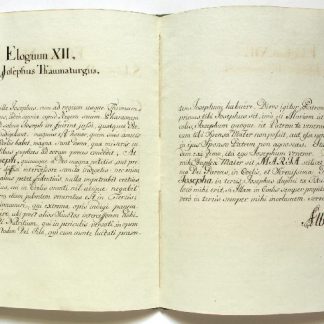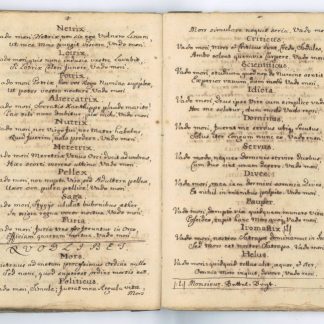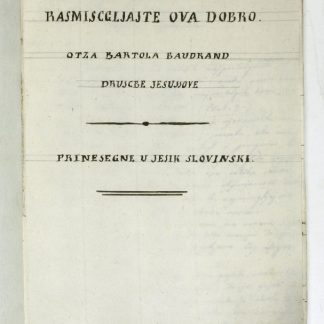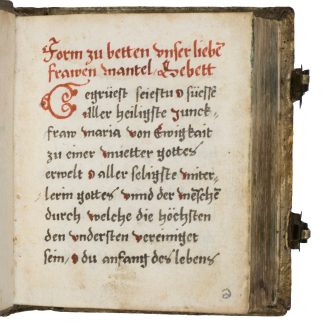Charming 16mo German manuscript prayerbook in contemporary blind-tooled pigskin
Form zu betten unser liebe[n] frawen mantel, Gebet. [Incipit:] Cegrüest seiestu o süesse aller heiligste junckfraw maria [...].
Small 16mo (85 x 100 mm). (423), (3 blank) pp. German manuscript in red and black ink on paper, written in an upright, semi-cursive gothic hand, with Lombardic initials in red, rubricated throughout. Contemporary blind-tooled pigskin over bevelled wooden boards, 2 strap fastenings with brass clasps.
€ 8,500.00
A charming, pocket-sized Catholic manuscript prayerbook in German, written in red and black, bound in contemporary blind-tooled pigskin, both manuscript and binding probably the work of a monastery in Ravensburg or the surrounding region.
The manuscript begins with prayers to the Virgin Mary on 19 leaves (a1-c3) and continues with three series of rosary prayers on 47 leaves (c3-i1), further prayers to the Virgin Mary on 28 leaves (i1-m4), prayers for various days from Palm Sunday to Easter on 18 leaves (m4-o5), prayers for the 24 hours on 56 leaves (o5-x4), further rosary prayers in five parts on 21 leaves (x4-z8), the litany of all saints on 20 leaves (z8-2c3), and the litany of specific saints, including St Augustine, on 10 leaves (2c3-2d4).
The manuscript is very regular in its structure, only a few blank leaves have been removed: the final quire used for the prayerbook text itself ends with a blank leaf, followed by stubs of 3 leaves that have been torn out. The quires that contain the text of the prayerbook collate: [a]-[2c]8 [2d]8 (- 2d6, 7, 8) = [212], [1 blank] ff. The 17th century binder trimmed most of the quire signatures (quire a probably had none), but on the first leaf of a few quires one can see the top of the letter that was shaved (confirming the collation): i, k, r, s. The top of some letter or mark, also shaved, can be seen in the same position on c3, f2 and 2d1-4, but it is not clear what they are. The endpapers appear to have been a quire of four leaves at the front and a quire of six leaves at the back, probably each with its first leaf removed and the outermost remaining leaf pasted down.
The paper is almost certainly of foolscap size, nearly all watermarked with the Ravensburg coat of arms (a castle represented as a gate between two towers, standing upon a corbel). The gate in the present watermarks probably has a door under a peaked roof, rather than a portcullis, but this and the initial(s) or other sign in the corbel are difficult to make out because each watermark is divided between four leaves with the central parts lost in trimming. The crenellated battlement of each tower is rounded, has three merlons, and sits directly on a rounded slab, the battlement having no narrower neck leading to the slab. Each tower has one window, connected to the wall on the gate side by (in most cases) two diagonal wires that form a triangle with the wall as its base and the point touching the window. We have not found an example in the literature with this triangular link, but otherwise the present watermarks resemble many from the period 1655 to 1675 (Piccard III, group IX, 171-186 & 253-259, plus many scattered throughout group VIII). Those in quires a, f and probably b and g have two initials (probably "HL") flanking the corbel; the literature shows no initials in that position before 1666. This suggests that the manuscript was probably produced in the period ca. 1665 to ca. 1675. One Ravensburg castle mark in WZIS has an HL monogram in the corbel, but not the initials flanking it, and the style of the castle is completely different: it is not clear whether it dates from 1666 or between 1686 and 1700. Not surprisingly, Ravensburg castle watermarks appear most frequently in Ravensburg (in Upper Swabia, just north of Lake Constance), but also in the vicinity (Konstanz, Weingarten, Salem, Überlingen); they are rare elsewhere.
The endpapers were probably made from one of the paper stocks used for the manuscript itself (one leaf shows one side of the foot of the Ravensburg castle watermark, with no initials flanking the corbel), suggesting that the production of the manuscript and its binding were closely tied, perhaps at a monastery in the region. Three bifolia show parts of a different watermark: two bifolia in quire c show a crown, perhaps from a coat of arms or an Imperial double-headed eagle, while one in quire l shows what may be the foot of a coat of arms or possibly the tip of the tail of an eagle, with scroll decorations.
In a 16mo in 8s, one expects each quire to represent a half-sheet, and each sheet would provide one half sheet with a watermark and one without. Here, eight quires show parts of a watermark in four of the eight leaves, and six show no watermark. But even these quires were not consistently made from regularly folded half sheets: some were assembled from separate bifolia, so that some of the watermarks appear at the foot of the fore-edge rather than its head. Most of the quires a-l and a few others show parts of watermarks in 1, 2 or 3 leaves, demonstrating that they contain bifolia from different half-sheets. In quire e, three leaves show one of the two towers from a Ravensburg castle watermark, proving that they come from parts of two different sheets (c and l, which include parts of a different kind of watermark, also mix bifolia from different sheets).
One or more early owners of the present manuscript have written six pages of further prayers on the endpapers (2 at the front and 4 at the back), mostly in a single contemporary hand, including "ein gebeid der Reponsori deß H. Bonaventura"; "So du nun mirackel suchst der Godt"; "Wo man alle nacht mit Jesu schlaffe soll"; "Fünff vögelen singen, daß es in den Rainen" (five songs, numbered 1 to 5). There is also a two-line inscription on the back pastedown. Parts of the front pastedown, which probably contained an owner's inscription, have been removed or obliterated, but bits of an early inscription remain visible.
Small 16mo in 8s (85 x 100 mm; leaf size 75 x 90 mm). [423], [3 blank] pp. plus 3 endleaves at the front and 5 at the back. German manuscript in red and black ink on paper, written in an upright, semi-cursive gothic hand, with Lombardic initials in red (a few 2-line and hundreds of 1-line initials), rubricated throughout. 11 lines per page, written space 55 x 70 mm. Contemporary blind-tooled pigskin over bevelled wooden (beechwood?) boards, sewn on 3 double supports, each board bearing a double rectangular border of multiple rules, inner frame with an oval centrepiece stamp (22 x 32 mm, the front with a female figure [the Virgin Mary or a saint?] within decorative borders; back divided by 2 diagonal double rules and 4 diagonal double arcs into 4 inner and 8 outer compartments, each filled with arabesque decoration; outer compartments coloured, inner compartments thus forming a lighter lozenge with concave sides). An arabesque stamp inside each corner of the inner border and a decorative border between the inner and outer frame composed of at least 2 straight branches with leaves and at least 4 rosettes (5, 6 and 7 petalled); spine and turn-ins rules. In total more than 100 impressions of about 9 stamps. Further with 2 strap fastenings with brass clasps (each with an owner’s [?] stamp: 1.5 mm Roman capital initials "LH" above a 3 mm head in profile, facing right), catchplates and anchor plates, plain headbands, blue edges. With 27 mm Roman capital initials "BR" in brown ink on the lower edge.
Some minor and mostly marginal foxing, a hole in l6 and 7, a small marginal tear in l8 and insignificant ones in a few other leaves, but still in good condition. The binding has a hole in the pigskin covering the spine, along one of the supports, is slightly soiled and most of the blue colouring of the edges of the leaves is lost. The centrepiece on the front board does not appear to be worn, but its image (probably the Virgin Mary or a female saint) is nevertheless difficult to make out: perhaps the binder did not impress it strongly. The binding also remains in good condition.

